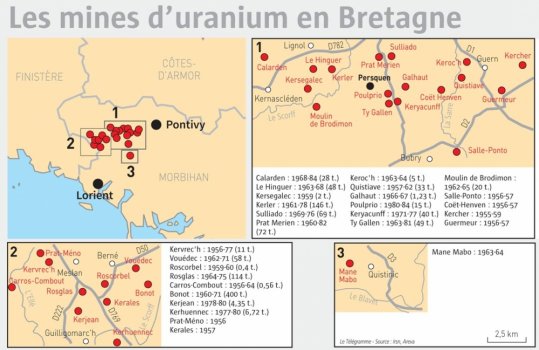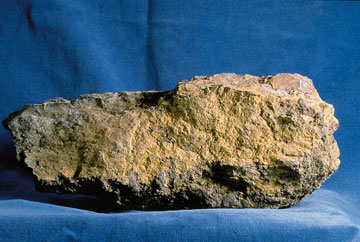Pendant trente ans, de la fin des années 1950 à 1985, vingt-deux sites d'uranium ont étés exploités entre Guilligomarc'h (Finistère) et Pontivy (Morbihan). Le bon filon minier du pays du Roi Morvan est géré au départ par la Simura, Société industrielle et minière d'uranium, le domaine devient propriété d'Areva, ex-Cogema, en 1986, et ceci jusqu'en 2018.
For thirty years, from the end of the 1950s to 1985, twenty-two sites of uranium were exploited between Guilligomarc'h (Finistère) and Pontivy (Morbihan). The good mining channel in the country of King Morvan is initially managed by Simura, an industrial and uranium mining company, the estate became property of Areva, ex-Cogema, in 1986, until 2018.

La mine de Kervrec'h / The Kervrec'h Mine
La mine de Kervrec'h aura été exploitée de 1957 à 1968 puis de 1976 à 1977 par le creusement d'un puit de 50 m et de galeries sur 3 niveaux entre -15m et -45m sous la surface du sol pour une longueur de 335 m. 3 500 tonnes de minerais auront étés extraits durant cette période.
En 1993 la COGEMA a procédé à des travaux de réaménagement du site en comblant intégralement le puits et le montage. Tous les ans une visite de contrôle est effectuée pour vérifier la stabilité des terrains situés à l'aplomb des travaux miniers souterrains.
The Kervrec'h mine was exploited from 1957 to 1968 and then from 1976 to 1977 by digging a 50 m well and galleries on 3 levels between -15m and -45m below the surface of the ground for a length of 335 m. 3 500 tonnes of minerals will have been extracted during this period.
In 1993, the COGEMA carried out work to redevelop the site by completely filling the well and the assembly. Every year, a control visit is made to check the stability of the plots of land underground.

L'uranium
L'uranium est un métal gris argenté environ deux fois et demi plus dense que le fer. Cet élément chimique porte le numéro atomique 92 et est le plus lourd présent naturellement sur Terre. Il existe de nombreux isotopes de l'uranium mais l’uranium naturel présent dans l’écorce terrestre n’est constitué que de trois isotopes : l'uranium 238, le plus lourd atome naturel et le plus abondant (99,28%), l'uranium 235 (0,71%) ainsi que des traces d’uranium 234 (0,006%).
Uranium is a silver gray metal about two and a half times denser than iron. This chemical element carries the atomic number 92 and is the heaviest present naturally on Earth. There are many isotopes of uranium, but the natural uranium present in the earth's crust consists of only three isotopes: uranium-238, the heaviest and most abundant natural atom (99.28%), Uranium-235 (0.71%) and traces of uranium-234 (0.006%).

L'uranium est un élément naturel assez commun : il est plus abondant que l'argent ou l'or et se trouve partout dans l'écorce terrestre surtout dans les terrains granitiques ou sédimentaires à des teneurs moyennes comprises entre 2,7 et 3 g par tonne.
Uranium is a fairly common natural element: it is more abundant than silver or gold and is found everywhere in the earth's crust, especially in granitic or sedimentary soils at average grades between 2.7 and 3 g Per tonne.
L'uranium a été mis en évidence en 1789 par le chimiste prussien Martin Heinrich Klaproth en examinant un morceau de roche provenant de Jáchymov, ville de l'actuelle République tchèque. Il lui donna le nom de « urane » ou « uranite » en référence à la découverte de la planète Uranus 8 ans plus tôt par William Herschel.
Le chimiste français Eugène-Melchior Péligot établit que la roche analysée par Klaproth est en réalité composée de deux atomes d'oxygène et d'un atome de métal qu'il appela « uranium ».
The uranium was discovered in 1789 by the Prussian chemist Martin Heinrich Klaproth by examining a piece of rock from Jáchymov, city of the present Czech Republic. He gave it the name "uranite" or "uranite" in reference to the discovery of the planet Uranus 8 years earlier by William Herschel.
The French chemist Eugene-Melchior Péligot establishes that the rock analyzed by Klaproth is actually composed of two atoms of oxygen and one atom of metal which he called "uranium".

La radioactivité de l'uranium ne fut découverte qu'en 1896 par Henri Becquerel lorsqu'il constata que des plaques photographiques placées à côté d'échantillons d'uranium avaient été noircies alors qu'elles n'avaient jamais été exposées à la lumière. Becquerel découvrit ainsi le phénomène de radioactivité et poursuivit son étude entre autre avec les époux Curie. Pour leur étude de la radioactivité, Henri Becquerel et Pierre et Marie Curie obtinrent le prix Nobel de physique en 1903.
The radioactivity of uranium was discovered only in 1896 by Henri Becquerel when it was found that photographic plates placed next to uranium samples had been blackened when they had never been exposed to light. Becquerel discovered the phenomenon of radioactivity and continued his study, among other things, with the Curie spouses. For their study of radioactivity, Henri Becquerel and Pierre and Marie Curie were awarded the Nobel Prize in Physics in 1903.
A l'origine, le minerai d'uranium était utilisé dans la céramique pour ses pigments jaunes, oranges et verts. Ce n'est qu'avec la découverte de la radioactivité que les premières applications médicales ont émergé. Le projet Manhattan a marqué le début de son utilisation à des fins militaires qui se sont poursuivies tout au long de la guerre froide. Aujourd'hui, les applications dans le nucléaire civil destiné à la production d'électricité et à la médecine sont prépondérantes.
Originally, uranium ore was used in ceramics for its yellow, orange and green pigments. It was only with the discovery of radioactivity that the first medical applications emerged. The Manhattan project marked the beginning of its use for military purposes, which continued throughout the Cold War. Today, applications in civil nuclear power generation and medicine are predominant.

D'un point de vue géologique / From a geological point of view
Le minerai naturel d'uranium est la pechblende, qui peut apparaître sous forme de filons métallifères. Selon les gisements, le minerai considéré comme exploitable a une teneur de l'ordre de 1 à 2 kg d'uranium par tonne de minerai (soit plusieurs centaines de fois la concentration naturelle moyenne du sol).
The natural ore of uranium is pitchblende, which may appear as metalliferous veins. According to the deposits, the ore considered exploitable has a grade of 1 to 2 kg of uranium per tonne of ore (several hundred times the average natural soil concentration).
Les dépôts d'uranium se situent à l'interface entre un socle d'âge archéen à protérozoïque inférieur et une puissante couverture de grès du protérozoïque moyen. Ils sont généralement associés à des failles à graphite et entourés de halos d'altérations argileuses de haute température.
Uranium deposits are located at the interface between an Archean to lower Proterozoic basement and a powerful proterozoic sandstone cover. They are generally associated with graphite faults and surrounded by high temperature clay alterations.

A Kervrec'h la mine d'uranium est située sur un massif granitique de Cascadec composé de granite à grain grossier, à biotite et muscovite contenant parfois de la sillimanite. Une minéralisation (pechblende et autunite) est présente au sein d'un petit filon de quartz d'environ 40 cm de puissance.
In Kervrec'h the uranium mine is located on a granite massif of Cascadec composed of coarse-grained granite, biotite and muscovite, sometimes containing sillimanite. A mineralization (pechblende and autunite) is present within a small quartz vein of about 40 cm of power.
Pour valider cette earthcache / To validate this earthcache
Loguez cette cache "Found it" et envoyez-moi vos réponses soit via mon profil, soit via la messagerie geocaching.com (Message Center), et je vous contacterai en cas de problème.
Q1 - Rendez-vous aux coordonnées de cette earthcache et lisez le panneau d'informations. Pouvez-vous indiquer la quantité d'uranium métal produites dans cette mine ?
Q2 -Toujours à l'aide des informations indiquées sur le panneau pouvez vous calculer la quantité de d'uranium collecté pour 1 tonne de minerai produite ?
Log this cache "Found it" and send me your answers either via my profile or via the geocaching.com (Message Center) mail, and I will contact you in case of a problem.
Q1 - Go to the coordinates of this earthcache and read the information panel. Can you indicate the amount of uranium metal produced in this mine?
Q2 -Always using the information on the panel can you calculate the amount of uranium collected for 1 tonne of ore produced?